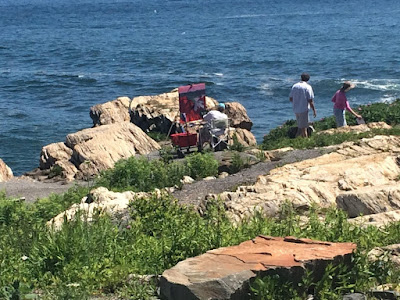It’s time to make some hard choices about my two wooden easels.
| The last cutting, v. 2, by Carol L. Douglas. Watercolor, same subject as yesterday, but turned the other way. This is one of those times where a square canvas would be appropriate. |
On Wednesday, I realized I’d lost my watercolor palette on Clary Hill. The palette—$14.79 at Jerry’s—is no big deal. It was, however, fully loaded with paint. That’s an expensive nick in the wallet.
I use an old Mabef tripod swing easel for watercolor. I’ve had it forever. It has been replaced by a larger version in most catalogues, but this old friend has been a reliable, versatile workmate for several decades. A few years ago, the head cracked on one side. I compressed and glued it so it worked again. The thumbscrew no longer tightens enough to hold the arm perfectly stable, so I prop it up with my knee when painting. For big boards, I’ve been taping the support to the easel’s head rather than trying to hold it mechanically.
On Tuesday in the dripping rain, that original crack opened back up again. I duct-taped it tightly and hoped for the best. Yesterday, the other side of the head cracked. Again, I taped it together. However, with no tension in the head, the arm is free to bounce around willy-nilly on its pivot. I’m afraid my old friend may be headed for the woodstove.
| With both sides of the head cracked, there is nothing to keep tension on the pivot head, and the arm can swing willy-nilly. |
There are many reasons to love wooden easels—they’re relatively cheap, they’re stable in high winds, and, properly cared for, they can last for years. However, they have two shortcomings. The first is that wood is heavy. Few modern-day plein air painters have donkeys or servants to carry our equipment up steep hillsides. When I was forty, this wasn’t a big issue. As I approach sixty, it has become a limiting factor. An aluminum pochade box and a lightweight tripod weigh a fraction of what a decent wood easel does.
Wood is hygroscopic. That means the moisture content changes depending on the relative humidity. That’s the killer for all unfinished wood used outdoors, and easels are no exception. My Gloucester easel—also old, purchased used many years ago—requires a rock to hammer the pins into place, because they’ve swollen over time.
 |
| Painting earlier this year with a Gloucester easel. It’s the only easel tough enough for on-shore winds. Photo courtesy of Karen Lybrand. |
That’s an easel with an interesting history. It is a traditional European design that was brought to Gloucester, MA, at the turn of the last century by painter Oscar Anderson. He made and sold them to fellow artists; old ones bear his name-plate. The Anderson easel became known generically as a “Gloucester easel.” Today there are two versions available—a beautifully milled, expensive one called the Take-It Easel, and a mass-produced one called the Beauport Easel. They work exactly the same, although I imagine the better-made one will last longer.
It’s a very stable design, and it has the great advantage of allowing work to tilt forward toward a sitting painter. Still, I don’t like to carry it any farther than I can trundle it in a wagon. Not only is it big and cumbersome, it is held in the folded position by only a canvas strap. (Mine rotted away years ago.) And it’s useless for watercolor, because the head doesn’t pivot.
 |
| Meanwhile, the unsettled Atlantic is giving us some very interesting sunrises. This was yesterday’s; this morning we were socked in with fog. |
I have a spare pivot-head easel in my studio in Rockport, and I’ll collect it on Saturday. It’s a Guerilla painter head that I adapted to hold a larger board. With its tripod, it weighs a ton, but that won’t matter for this residency. After that, I’ll take apart both my wooden easels and make some hard choices. Can they be rehabbed, or must they be replaced?





